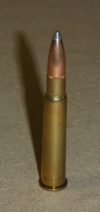Soft point bullet


A soft-point bullet, also known as a soft-nosed bullet, is a lead bullet with a copper or brass jacket that is left open at the tip, exposing some of the lead inside and is thus an example of a semi-jacketed round. Side by side comparison with of hollow point bullet and FMJ ammunition will quickly illustrate the difference.
After the introduction of cordite as a propellant it was noted that lead bullets fired at the higher velocities cordite allowed were readily stripped as they travelled along the barrel. This led to significantly faster fouling of the barrel as lead deposits built up particularly on rifled barrels. Bullets were jacketed to prevent fouling, although these inflicted less severe wounds. Partially jacketing the bullet allowed the bullet to foul the barrel less while also exposing the soft tip which is designed to expand upon impact and to spread open the harder metal jacket. The mechanism is the same as hollow point bullets, but the lack of a hollow depression reduces the area upon which the hydraulic pressure can act on the lead, and thus the soft point bullet expands more slowly than a hollow point.
Soft point bullets are less common than hollow points, due to the slower expansion and greater penetration, but they fill a couple of roles that hollow points do not. In some cases the reduced expansion is desired, so that more penetration is achieved before the bullet begins the rapid deceleration caused by expansion. In other cases, the smooth, rounded profile typical of a soft point bullet is preferred over the concave tip of a hollow point, because the latter tends to jam while feeding in certain magazine-fed firearms. Many of the more modern magazine-fed firearms were expressly designed to feed hollow points reliably, but many older and military-derived designs were not. Many military firearms, especially pistols, were designed to fire only full metal jacket bullet (FMJ) ammunition, and will suffer failures to feed with hollow point ammunition, leaving soft point ammunition the best choice for non-military defensive purposes. Military firearms are designed to use FMJ rounds because JSP/JFP and JHP rounds are specifically prohibited by the Hague Conventions (1899 and 1907) which disallow the use of bullets which are designed to expand between nations which are signatory to the convention. However, this convention does not apply to use on a nation's civilian population.
Jacketed soft point is usually abbreviated JSP in the ammunition and reloading industry. Jacketed flat point (JFP) is also used for soft point bullets with a flat, rather than a rounded front. Flat point bullets are required in centerfire rifles with tubular magazines, such as the Winchester rifle, where the rounds are stored front-to-back. Use of pointed bullets in these rifles can be highly dangerous, as the point of the bullet will rest against the primer of the round in front of it and can cause a detonation under the force of recoil.
